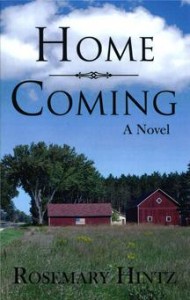Home Coming – A Novel – By Rosemary Hintz
- Share
- Tweet
- Pin
- Share
In the follow up to her first novel, Return to Sawyer School, Rosemary Hintz delivers yet another captivating novel about growing up during the war years of the 1940s in Home Coming. Told through the eyes of a young girl, Robbie, the novel captures the essence of the times with an air of innocence and (sometimes) simplicity that makes this novel inviting and hard to put down.
The story revolves around a family of 10, living in Door County at the time when the United States entered WWII. The children vary in ages, and Hintz brings out ample emotion in the reader when describing how the mother feels when her children decide to enlist in the armed forces, especially when Hilda, the eldest daughter, enlists in the WAAC. One by one, the children leave the house, while at the same time; the war is impacting their lives in ways they never could have imagined. When one of the sons, Paul, gets drafted, Hintz delivers dialogue that would pull at any mother’s heart strings, writing, “‘They’ll kill him!…He’ll never defend himself!’ Paul was a gentle spirit. We couldn’t imagine him hurting anyone.”
When a member of the family dies, the novel takes on a more affecting tone, describing the deterioration of a seemingly solid family unit. Hintz describes Robbie’s emotional state in a way that makes the reader have no choice but to feel the same. She then goes on to tell Robbie’s story, her experiences and how she views the world around her. Hintz has a perfect balance of light-heartedness and seriousness that make the novel captivating enough to keep the reader’s attention.
Robbie gives a unique perspective to the events occurring around her, since she is only 10 years old at the beginning of the novel. While most of us have learned in history classes the sacrifices everyone had to make during war time, this is all new to Robbie. The rationing of gas, sugar, meat, clothing, shoes and fat (used for ammunition), as well as the idea of Government Bonds were all new to the young girl.
Although the novel takes place in the 1940s, Hintz incorporates many ideas, places, and types of people that can still be found in Door County today.
About war she writes, “…why do we have to have a war? Why do men fight and kill one another? It’s barbaric! They should be able to talk and resolve their differences.” This is a great example of the maturity Robbie’s character exhibits. This aspect of her personality remains constant throughout the novel and gives the novel an optimistic feel.
While discussing the tourism in Door County (which was still abundant back then), she calls the tourists “summer people” and writes, “…folks from Milwaukee or St. Paul dressed in their summer finery, men in white shirts and tan pants with wing tip shoes probably on their way back to their cottage after a hard afternoon on the golf course.” With this example, Hintz exhibits how while Door County has changed a lot since the 1940s, it is still the place for vacationers to visit to have a fun and relaxing time.
In addition to the tourism, Hintz mentions a lot of places in Door County that used to exist, and some that still do. Robbie often goes shopping at Pranges, Goettleman’s Variety Store and Trodahl’s Grocery Store. They visit Potawatomi Park, drive on Tacoma Beach Road, eat at Samuelson’s, and if someone needed to be hospitalized, they went to Dorchester Hospital. For long-time residents of Door County, these locations may bring back many memories.
I thoroughly enjoyed Home Coming, especially all the mentions of kids playing games outside. It was a nice break from the technological age that we find ourselves in. And the fact that Hintz used Robbie’s hand as an example of a map of Wisconsin had me laughing out loud (only because I do it myself). Hintz describes the era accurately, and the plot embedded with emotion will keep the reader’s interest.
Amanda Veldboom lives in Seymour, WI with her husband and 15-month-old daughter. She graduated from UWGB in 2008 with a Bachelor’s Degree in English Literature with a Women’s Studies minor.



